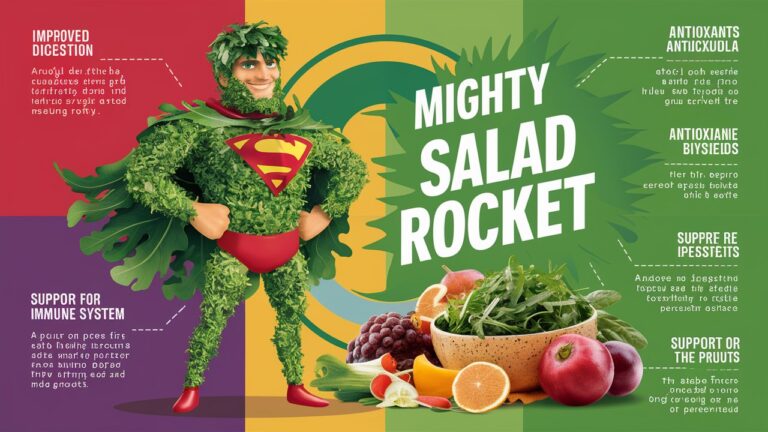Introduction: More Than Just a Peppery Green
Often overlooked in favor of kale or spinach, arugula (Eruca sativa), affectionately known as salad rocket, roquette, or rucola, is a nutritional powerhouse with a distinctive peppery flavor. This cruciferous vegetable, native to the Mediterranean region, belongs to the esteemed Brassica family alongside broccoli, kale, and Brussels sprouts 16. Beyond its culinary versatility, arugula boasts an exceptional nutrient profile rich in cancer-fighting compounds, bone-strengthening minerals, and vision-protecting antioxidants. Modern research continues to validate what ancient civilizations instinctively knew—this leafy green offers profound health benefits ranging from cardiovascular protection to diabetes management. Its low-calorie nature coupled with high nutrient density makes it an ideal addition to any health-conscious diet, offering protection against chronic diseases while enhancing everyday vitality.
1. Cancer Prevention: Cruciferous Defense Mechanisms
Arugula’s most compelling superpower lies in its glucosinolates—sulfur-containing compounds responsible for its characteristic pungent aroma and bitter taste. When chopped or chewed, these compounds convert into isothiocyanates like sulforaphane and erucin, which demonstrate potent anticancer activity across numerous studies 148. These bioactive molecules neutralize carcinogens, inhibit tumor growth, and induce apoptosis (programmed cell death) in cancerous cells. Population-based research consistently links high cruciferous vegetable consumption with reduced risks of lung, breast, prostate, colorectal, and pancreatic cancers 14. Unlike some cooked crucifers, arugula is typically consumed raw, preserving its myrosinase enzyme activity, which maximizes the bioavailability of these protective compounds 3. Regular inclusion in the diet acts as a preventive strategy against cellular mutations, positioning arugula as a delicious dietary defense in the fight against cancer.
2. Bone Health: Calcium Synergy with Vitamin K
Arugula excels as a triple-threat supporter of skeletal strength. While many greens offer calcium, arugula provides 160 mg per 100 grams alongside significant magnesium and phosphorus—minerals critical for bone mineralization 26. Its standout feature, however, is exceptionally high vitamin K1 content: just two cups deliver over 90% of the Daily Value, a nutrient so vital for bone integrity that it outperforms calcium in fracture prevention according to clinical research 168. Vitamin K activates osteocalcin, a protein that binds calcium to the bone matrix, preventing osteoporosis and improving bone mineral density. Studies confirm that individuals with higher vitamin K intake experience lower rates of hip fractures and slower age-related bone loss. Unlike dairy-based calcium sources, arugula’s alkaline nature may help preserve calcium stores by reducing acid-induced bone resorption, making it an essential green for maintaining lifelong skeletal resilience.
3. Cardiovascular Protection: Nitrates and Blood Pressure Regulation
Arugula’s heart-protective properties stem from its unique combination of dietary nitrates, potassium, and antioxidants. Natural nitrates convert into nitric oxide within the body, a molecule that relaxes blood vessels, improves endothelial function, and enhances blood flow 24. This vasodilatory effect, coupled with 370 mg of potassium per 100 grams, counteracts sodium-induced hypertension by reducing arterial stiffness and improving circulatory efficiency 12. Additionally, antioxidants like lutein, zeaxanthin, and vitamin C prevent LDL cholesterol oxidation—a key trigger for atherosclerosis 28. The fiber content further aids cardiovascular health by binding excess cholesterol in the digestive tract. Epidemiological studies indicate that diets rich in leafy greens correlate with a 16% reduction in cardiovascular disease incidence, partly attributed to their anti-inflammatory and lipid-balancing effects 34. Regular consumption supports healthy blood pressure, reduces arterial plaque formation, and optimizes overall vascular performance.
4. Vision Preservation: Carotenoid Armor for Eyes
The vibrant green hue of arugula signals its richness in carotenoid antioxidants, specifically lutein and zeaxanthin, which concentrate in the retina’s macula to form a protective pigment layer 28. These compounds act as natural blue-light filters, shielding delicate photoreceptor cells from oxidative damage caused by UV radiation and digital screens. Research confirms that higher dietary intake of these carotenoids significantly lowers the risk of age-related macular degeneration (AMD) and cataracts—leading causes of irreversible blindness in older adults 213. Arugula also provides substantial vitamin A (308 mcg RAE per 100g) in the form of beta-carotene, essential for night vision and corneal health 113. Unlike supplement forms, the natural matrix of phytonutrients in arugula enhances bioavailability. Regular consumption contributes to optical tissue integrity, contrast sensitivity, and long-term visual acuity, making it a strategic dietary component for screen-heavy lifestyles and aging eyes.

5. Diabetes Management: Alpha-Lipoic Acid and Insulin Sensitivity
Arugula emerges as a strategic ally for blood sugar regulation through multiple mechanisms. It contains alpha-lipoic acid (ALA), a potent antioxidant shown in clinical studies to increase insulin sensitivity, reduce peripheral neuropathy, and lower fasting glucose levels 248. The vegetable’s high fiber content (1.6g per 100g) slows carbohydrate digestion, preventing postprandial spikes 211. Furthermore, arugula seeds and leaf extracts demonstrate antidiabetic effects in experimental models, enhancing glucose uptake in skeletal muscle and adipose tissue while reducing hepatic glucose production 28. With only 1.5g net carbs per cup and minimal calories, it allows voluminous consumption without impacting glycemic load 11. Population studies consistently correlate high leafy green intake with reduced type 2 diabetes incidence, attributable to their magnesium content (which improves insulin receptor function) and anti-inflammatory phytonutrients that mitigate metabolic stress. Integrating arugula into meals offers a food-based strategy for diabetes prevention and management.
6. Weight Management: Satiety Through Nutrient Density
Arugula’s exceptional nutrient-to-calorie ratio makes it a cornerstone for sustainable weight control. Two full cups contain merely 10 calories yet deliver 20% DV for vitamin A, 36% DV for vitamin K, and 7% DV for vitamin C, alongside satiating fiber and water content 811. The dietary fiber (0.6g per cup) swells in the stomach, triggering stretch receptors that signal fullness while slowing gastric emptying 211. Unlike calorie-restrictive diets that leave you feeling deprived, arugula adds volume and crunch to meals without significant energy addition. Its peppery flavor also enhances sensory satisfaction, reducing cravings for high-calorie dressings or toppings. Studies indicate that starting meals with large, low-calorie salads significantly reduces total calorie intake during the meal. By providing essential micronutrients often lacking in reduced-calorie diets—like folate, calcium, and potassium—arugula helps prevent nutritional deficits during weight loss, supporting metabolic function and long-term adherence to healthy eating patterns.
Table 1: Comprehensive Nutritional Profile of Raw Arugula (Per 100g)
| Nutrient | Amount | % Daily Value |
| Vitamin K | 108.6 mcg | 90% |
| Vitamin C | 15 mg | 25% |
| Folate | 97 mcg | 24% |
| Calcium | 160 mg | 16% |
| Vitamin A | 308 mcg | 34% |
| Potassium | 370 mg | 10% |
| Magnesium | 47 mg | 11% |
| Fiber | 1.6 g | 6% |
| Lutein+Zeax. | 3555 mcg | – |
| Nitrates | ~250 mg | – |
| Source: 1211 |
7. Culinary Versatility: Maximizing Benefits Through Preparation
Arugula’s culinary flexibility allows seamless integration into diverse cuisines while preserving its nutritional integrity. Raw consumption maximizes glucosinolate retention, making it ideal for salads, wraps, and garnishes 19. Its peppery zing enhances:
- Pizzas and flatbreads: Adds fresh contrast to melted cheeses
- Grain bowls: Provides texture against quinoa or farro
- Pesto: Replaces basil for a spicy, nutrient-dense sauce 1
- Smoothies: Imparts phytochemicals without overwhelming flavors
Light sautéing in olive oil increases bioavailability of fat-soluble vitamins A and K while mellowing its pungency 6. Pairing with citrus or berries enhances iron absorption while balancing bitterness 1. Baby arugula offers a milder option for sensitive palates. To preserve freshness, store unwashed leaves in a sealed container with paper towels for up to one week 3. Avoid high-heat methods like boiling, which degrade heat-sensitive nutrients like vitamin C and myrosinase. Strategic preparation transforms this functional food into daily gastronomic pleasure.
Table 2: Creative Arugula Applications for Enhanced Nutrition
| Application | Recipe Idea | Nutrition Synergy |
| Detox Salads | Arugula + mango + walnuts + balsamic | Vitamin C boosts iron absorption; fats increase carotenoid uptake |
| Heart-Healthy Sides | Sautéed arugula with garlic + sun-dried tomatoes | Allicin (from garlic) enhances cardiovascular benefits |
| Protein Pairing | Arugula salad with smoked salmon + avocado | Omega-3s + fiber reduce inflammation |
| Bone-Building Blends | Arugula + shaved almonds + lemon dressing | Almond calcium + vitamin K for bone matrix formation |
| Diabetic-Friendly Meals | Arugula + grilled chicken + chickpeas + olive oil | Fiber + protein stabilize blood sugar |
| Inspired by: 26 |
8. Special Considerations: Safety and Interactions
While generally safe, arugula presents specific considerations for certain populations. Individuals on blood-thinning medications (warfarin, Coumadin) must maintain consistent vitamin K intake, as sudden increases can reduce anticoagulant efficacy 1410. Thyroid patients should consume raw arugula in moderation due to goitrogens that may interfere with iodine uptake, though cooking mitigates this effect 13. Although rare, allergic reactions resembling pollen-food syndrome have been reported, particularly in those sensitive to mustard plants 313. The high nitrate content (~250mg/100g) warrants caution for those taking nitrate-based angina medications like nitroglycerin, due to potential additive effects 14. Excessive consumption may cause digestive discomfort from fiber overload, especially when introduced abruptly. Always wash thoroughly to minimize pesticide exposure. For most people, 1-2 cups daily provides benefits without risks, but consult healthcare providers when making significant dietary changes alongside medications.
Conclusion: Embracing the Rocket Revolution
Arugula transcends its role as a mere salad component, standing as a scientifically supported functional food with multifaceted health applications. From its cancer-preventive glucosinolates to its bone-fortifying vitamin K, cardiovascular-supportive nitrates, and vision-protective carotenoids, this humble green delivers exceptional nutritional value per calorie. Its versatility in raw and lightly cooked preparations makes integration into daily diets both practical and pleasurable. While mindful consumption is advised for specific medical conditions, the evidence overwhelmingly positions arugula as a strategic dietary inclusion for longevity and vitality. As research continues to unravel its phytochemical complexity, one truth remains evident: embracing the peppery power of salad rocket offers a delicious, evidence-based pathway to enhanced well-being.
Frequently Asked Questions (FAQ)
Q1: Can arugula interfere with blood-thinning medications?
A: Yes, arugula’s high vitamin K content (108.6 mcg per 100g) plays a crucial role in blood clotting and may reduce the effectiveness of anticoagulants like warfarin. Patients on these medications should maintain consistent intake rather than avoiding it entirely and consult their healthcare provider before making dietary changes 1410.
Q2: Does arugula support weight loss effectively?
A: Absolutely. With only 10 calories per two cups, high water content, and 1.6g fiber per 100g, arugula promotes satiety without significant calories. Its nutrient density also prevents micronutrient deficiencies during calorie restriction, making it an ideal weight-loss food 2611.
Q3: How does arugula compare to spinach or kale nutritionally?
A: Arugula contains comparable vitamin K to kale but less vitamin C than either. Its advantage lies in higher glucosinolate concentrations than spinach and unique nitrates absent in both. Arugula also provides more calcium per calorie than kale 168.
Q4: Is raw or cooked arugula healthier?
A: Raw consumption preserves heat-sensitive compounds like vitamin C, myrosinase (needed for sulforaphane activation), and glucosinolates. Light sautéing improves bioavailability of fat-soluble vitamins. For maximum benefits, incorporate both forms 168.
Q5: Can arugula improve eye health?
A: Yes, its lutein (1848 mcg) and zeaxanthin (3555 mcg combined per 100g) accumulate in the retina, filtering harmful blue light and reducing risks of macular degeneration. Vitamin A content further supports corneal health 2813.
Q6: Are there any populations who should avoid arugula?
A: Those with oxalate-containing kidney stones may limit intake due to moderate oxalates. People with severe mustard allergies should exercise caution. Thyroid patients on medication should consult doctors regarding raw consumption volume 313.
